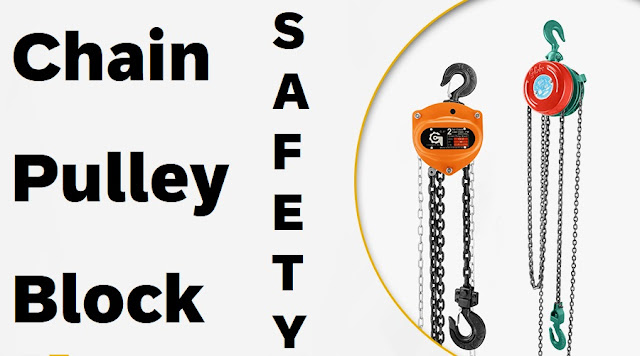Chain Pulley Block Safety
Safety Training Videos with Pictorial Guidelines
Chain Pulley Blocks are one of the general
rigging appliances and it is used for short lifts such as by small monorail
cranes, fixed hoists and so on.
Ensure the safe storage. Do not
drop a chain block. The jolt may distort the casing causing the gearing to
malfunction and the chain block to fail. The drive pinion could also part from
the main driving spur wheel.
Make sure that the hook has not
dipped through itself in a two part or multiple chain fall causing the load
chain to twist.
Always keep chain pulley blocks
away from sand, grit and dust. Some employees keep the load chain lightly oiled
to create less friction. If the chain is
oiled and it becomes covered in sand or grit, the grit turn out to be a grinding
paste which wears the chain very quickly.
RESPIRATORY PROTECTION – Definition of Terms
Periodic inspection by the user to be done and peruse inspection before every use to be done. Color coding is one of the best practice followed in industry.
Third party inspection by the
competent authority to be done as per the local government regulations.
Chain blocks with multiple falls are often very heavy on the opposite side to the block. It is a good practice to mouse the block to the head sling, to prevent the hook from dropping out of the head sling when the weight is released from the block.
Maintenance of Chain Pully Blocks
Authorized person has to inspect
the brake lining material for signs of wear and have it replaced if necessary,
ensuring the retaining rivets (if any) are well countersunk.
Thoroughly check the pawl for sharpness and alignment, the pawl spring for effectiveness, and the ratchet teeth for sharpness and wear.
Check the bearing bushes for wear
and have them renewed if necessary.
Remove the gear case and inspect the gears for wear on the shafts, and also for bending, breakage, wear, and misalignment of teeth.
Check the load chain for wear and for stretch and the load sheaves for excessive wear. If the load chain does not fit accurately it should be replaced before using the block.
Workplace Risk Assessment: A Key Step in Improving Safety
Inspect the load chain guide for movement. This guide should be the fixed type not a small roller. The purpose of the guide is to guide the load chain, free of turns, on to the gypsy. If a roller guide is fitted, hang the block up and while lowering the empty hook, gently twist the ascending chain as it approaches the guide roller. If it jams, a new guide must be fitted.
Check the hooks for opening out due to overloading or misuse. Examine the hook yokes, ball bearing swivels and anchorages of chain to clevis pins.
Where a chain block needs major overhaul or repair, advice should be sought from the supplier about the work to be carried out, and should be done by people who are competent.
Chain blocks must be lubricated lightly. If too much grease is pumped into a chain block the grease could cover the brake and the chain block would fail.
Do not leave a chain block soaking in oil. The oil will saturate the brake.

No comments:
Post a Comment